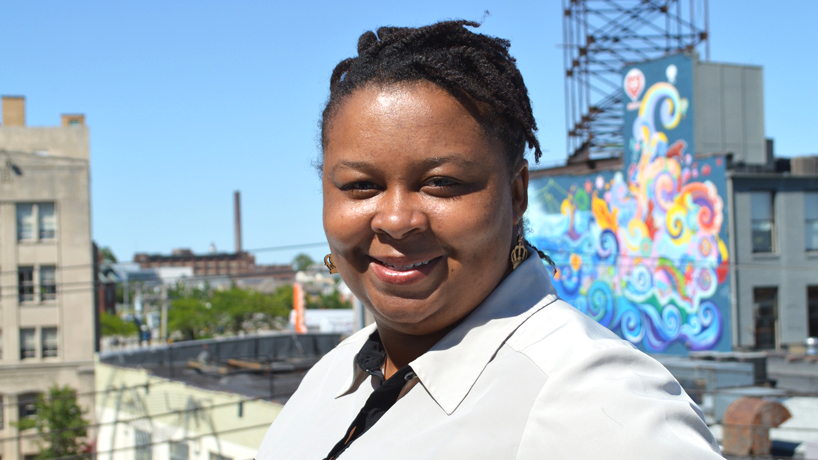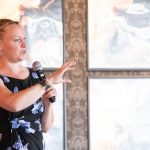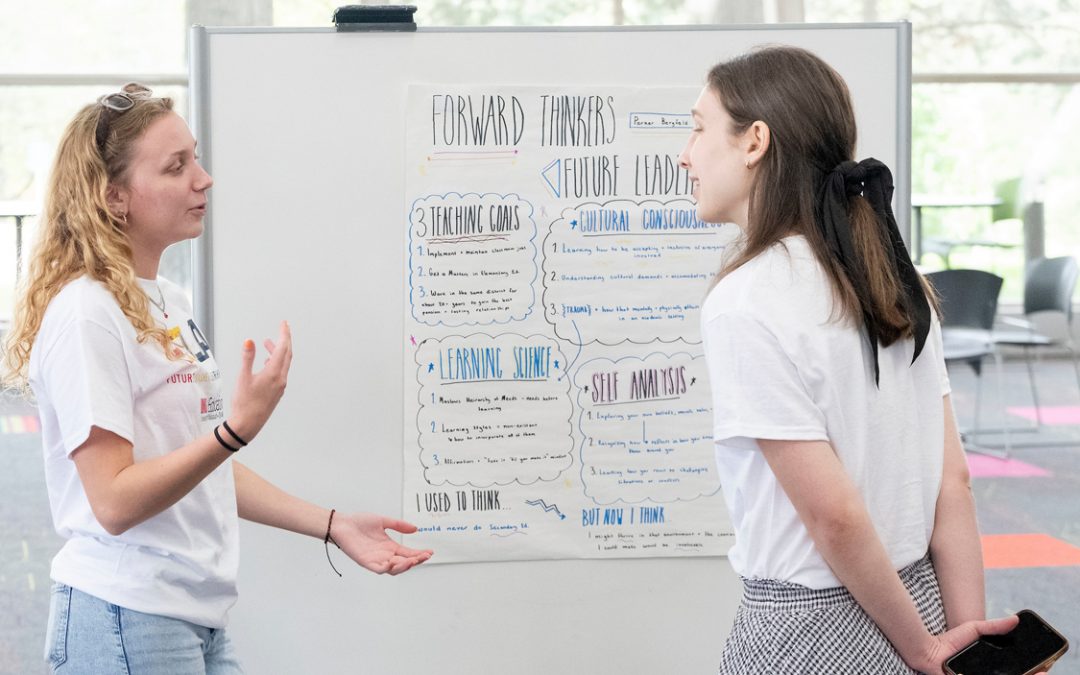
Antionette Carroll, who holds both a BS and an MA from UMSL, founded Creative Reaction Lab in 2014. (Photo by Evie Hemphill)
Antionette Carroll had just begun leading a national diversity and inclusion initiative three years ago when events in her own community sparked a unique sense of urgency for the University of Missouri–St. Louis alumna.
Living in Ferguson, Missouri, at the time, she didn’t sit back as protests erupted following the shooting of Michael Brown. Instead she got to work – and got people together to help make change.
“My mindset was, ‘Let’s not just talk about it,’” Carroll says. “‘Let’s do it. Let’s try it.’”
On Aug. 23, two weeks after Brown’s death, Carroll and a handful of fellow designers as well as technologists and activists arrived at UMSL’s Innovative Technology Enterprises building for what would prove to be an intense 24 hours. Their task? Developing practical initiatives addressing racial inequality and police brutality.
“I slept for an hour, but there were some people who did not sleep at all,” says Carroll, who earned undergraduate and master’s degrees from UMSL in 2009 and 2011, respectively. “I challenged them to come up with an idea and a plan for it, and they actually had to think of it like a business – how would you market this, how would you sustain this, who are community stakeholders to partner with. So they needed all 24 hours to do it.”
Along with five design projects that have since been implemented, those initial overnight efforts launched an entire organization known as Creative Reaction Lab.
The St. Louis-based nonprofit has grown under Carroll’s leadership and now aims to challenge not just individuals but whole cities to think big about equity. For Carroll, that starts with design – which might seem counterintuitive.
“Even in the design industry, one of the first challenges I had to overcome was having designers look at their talent and their expertise and their skill as more than just creating a poster or a website,” says Carroll, who is also president of the St. Louis chapter of AIGA, the professional association for design. “Design has so much more value. It’s a process, a mindset.”
Everyone is a designer in a sense, Carroll adds, and from clothing to tables to buildings, everything tangible has been designed. But there are less visible designs in place, too, such as societal structures and policies – some of them deeply problematic and in need of solutions.
“Kind of our tagline here is that racial inequities are by design, so therefore only intentional design can dismantle it,” Carroll says. “It’s the same when you think about systems of oppression – these are systemic designs. Redlining was a systemic design. Mass incarceration was a systemic design.
“If you look at the life expectancy between black residents and white residents of St. Louis, there’s an 18-year life-expectancy gap. That’s not an individual life – that’s a full culture and a full design that’s been put in place.”
With such injustices and inequities in mind, Carroll and her colleagues work primarily with black and Latinx youth to co-create solutions and develop the next generation of civic leaders. It’s a method that builds on design thinking and human-centered design – the leading approach to creative problem solving in the design industry – with a new idea: equity-centered design.
Among other things, that involves bringing people from very different backgrounds together – a CEO, a fast-food worker and an artist, for example.
“Equity-centered design starts with more than empathy,” Carroll explains. “You have to first start with humility and take into account power dynamics. And you have to have some people recognize the expertise and value they bring to the table, and you have to have others be willing to share the space to support them to truly co-create together. So that is part of our process besides doing and making at the same time.”
And what exactly are they making? Change, in a word, but what that looks like varies.
While the organization has spearheaded additional 24-hour challenges around gun violence, domestic violence and other issues since that first challenge in August 2014, Creative Reaction Lab’s main focus has shifted to efforts such as its school-year-long program for youth called Design to Better Our City and a Young Leaders for Civic Change boot camp.
Meanwhile, Carroll is also making headlines. This spring she was named one of Essence magazine’s “Woke 100 Women” alongside activists including writer/producer Shonda Rhimes and Sybrina Fulton, mother of Trayvon Martin.
“The editor sent me a note saying, ‘Congratulations, you are being featured as one of Essence magazine’s 100 woke women,’ and I was like, ‘Oh, wow,’” Carroll says.
The recognition in April marked the first time the magazine has honored “women who are blazing trails for equal rights and inclusion for Black people in America.”
But Carroll has been blazing trails for some time – including at UMSL where she was named among the university’s 2008 Trailblazer awardees as a student and was lauded by the Sue Shear Institute for Women in Public Life as its Amethyst Honoree in 2013.
Even as an undergraduate, she was taking the lead on multiple fronts and also taking a lot of classes in many areas.
Although she graduated in 2009 with a degree in media studies, she also completed significant biology and design course work along the way, and she earned certificates in writing and advertising. She earned her graduate degree in communication with emphases in nonprofit management and organizational behavior.
More than anything, she says, the seminar-style courses she took through the Pierre Laclede Honors College with instructors like Nancy Gleason and Birgit Noll stand out.
“I appreciated those classes more,” Carroll says, “and it was in them that I started to really learn about genocide in Rwanda, for instance, and cultural violence and just get more of a specialized knowledge around social justice spaces.”
Thinking critically about such issues continues to inform her life and work, perhaps more than ever.
“Ferguson could have happened in anyone’s backyard, and as we saw, it did,” Carroll adds. “And it continues to do so, because our country was founded on erasure, on oppression. I’m not saying it’s not a great country, but it’s great for certain populations.
“And until we accept that – like other countries have started to do – we’re going to continue to be on that hamster wheel where we say, ‘Oh, we need to address this issue, this is a problem.’ And then you’re going to have the other people outside the hamster wheel saying, ‘That’s their problem, I don’t know what you’re talking about.’”
A first-generation college student, Carroll excelled at UMSL and even took on multiple leadership roles on campus while in many ways navigating the university experience on her own. She was president of the Associated Black Collegians, part of the founding committee for the Black Leadership Organizing Council, vice president of the Golden Key International Honour Society, a student senator, the advertising coordinator for the University Program Board – the list goes on.
“The other day I was writing this [list] out for somebody and I thought, ‘Whew, I don’t remember doing all that,’” she says with a laugh.
One semester she was heading up five different student organizations, taking 20 credit hours and completing an internship at Express Scripts.
It all seems to have been excellent preparation for her very full plate of current pursuits, which along with Creative Reaction Lab and AIGA involve being a mother of twins and a partner to her husband, Nicholas.
“If it wasn’t for him I probably wouldn’t be on the journey I am now,” Carroll says, also crediting her grandparents, who raised her. “He actually gave me the confidence to do it.”















